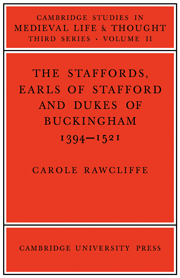Book contents
- Frontmatter
- Contents
- Dedication
- Acknowledgements
- Abbreviations
- Introduction
- 1 THE RISE OF THE STAFFORD FAMILY, 1343–1460
- 2 THE SECOND AND THIRD DUKES OF BUCKINGHAM, 1460–1521
- 3 THE MANAGEMENT OF THE STAFFORD ESTATES, 1438–1521
- 4 THE FIRST DUKE OF BUCKINGHAM'S HOUSEHOLD AND RETINUE, 1438–1460
- 5 CHANGES IN THE DUCAL LIFESTYLE, 1460–1521
- 6 THE FINANCES OF THE STAFFORDS, 14OO–1473
- 7 THE FINANCES OF THE STAFFORDS, 1473–1521
- 8 THE STAFFORDS AND THEIR COUNCIL
- 9 THE STAFFORDS AND THE COMMON LAW
- CONCLUSION
- APPENDICES
- Manuscript Sources
- Printed Sources
- Index
5 - CHANGES IN THE DUCAL LIFESTYLE, 1460–1521
Published online by Cambridge University Press: 07 October 2011
- Frontmatter
- Contents
- Dedication
- Acknowledgements
- Abbreviations
- Introduction
- 1 THE RISE OF THE STAFFORD FAMILY, 1343–1460
- 2 THE SECOND AND THIRD DUKES OF BUCKINGHAM, 1460–1521
- 3 THE MANAGEMENT OF THE STAFFORD ESTATES, 1438–1521
- 4 THE FIRST DUKE OF BUCKINGHAM'S HOUSEHOLD AND RETINUE, 1438–1460
- 5 CHANGES IN THE DUCAL LIFESTYLE, 1460–1521
- 6 THE FINANCES OF THE STAFFORDS, 14OO–1473
- 7 THE FINANCES OF THE STAFFORDS, 1473–1521
- 8 THE STAFFORDS AND THEIR COUNCIL
- 9 THE STAFFORDS AND THE COMMON LAW
- CONCLUSION
- APPENDICES
- Manuscript Sources
- Printed Sources
- Index
Summary
The modifications of administrative procedure which took place during the third Duke of Buckingham's lifetime were not confined to his estates. As we have already seen, the transition towards a more sedentary household provided a great impetus for reform, and also brought about a number of striking changes in the size and composition of the Stafford retinue. Duke Edward, his servants and modest following established themselves at Thornbury; they spent long periods in London and the surrounding manors, but never travelled north and because of local hostility did not dare to visit Wales. The rebuilding of Thornbury Castle – the major undertaking of Duke Edward's later years – was seriously begun in 1511 and still remained unfinished when he was beheaded. His plans, however, were near enough completion to confirm all Henry VIII's worst suspicions, and it is easy to see how these fears were generated. Most of the Staffords' larger manors and all their castles contained ‘service lodgings’, but when completed those at Thornbury would in size have surpassed them all. Three courts intended to house retainers were partly built by 1518; they stood apart from the other servants' quarters so that armed men could be mustered quickly in emergencies. Two large turreted gate houses, emblazoned with the family arms, crests and mottoes, also served as a tangible manifestation of the Duke's unrivalled position in the South West. The defences were to have been strengthened by a deep moat, gunports and a massive portcullis, while the armoury was already stocked with three pieces of ordnance.
- Type
- Chapter
- Information
- The Staffords, Earls of Stafford and Dukes of Buckingham1394–1521, pp. 86 - 103Publisher: Cambridge University PressPrint publication year: 1978



